1.7 Carolinian Plant
Bethany Vandenheuvel
 Viola Sororia
Viola Sororia
Author: Bethany Vandenheuvel
In this section:
1. Plant Description
Viola Sororia, also known as the blue violet, comes from the flowering plants called Violaceae. They are perennial, therefore they re-grow each year from the same root (NC State Extension Publications, n.d.). It is also an herbaceous vascular plant, so it does not contain any woody tissues. Viola sororia does not contain roots; instead, they uses rhizomes that grow horizontally to reproduce asexually. Additionally, they can also reproduce with closely related species in the Violaceae family, as it is interfertile.
2. Identification
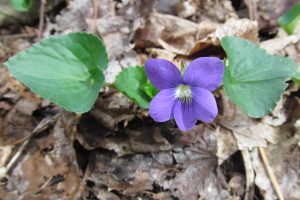
These violets are native to eastern, northern and central America from Quebec to Florida and west to Saskatchewan and Texas (New Moon Nursery, n.d.). Viola Sororia is a short, stemmed, non-woody plant that thrives in shady, well-drained, moist soil environments. This species is drought-tolerant, although the foliage tends to yellow in dry or sunny conditions, so moist soil is ideal. You can easily identify a viola sororia by observing:
- Flowering: Bilateral symmetrical. Produces flowers in spring and in the summer, they flower but remain closed to produce fruits with fertile seeds (cleistogamous flowers) (Northern Ontario Flora, 2018). You will commonly see butterflies and bees surrounding them due to their nectar.
- Leaves: Glossy, heart-shaped, with a scalloped edge
- Size: 15–25 centimetres wide. They can grow to be about 10cm in height
- Stem: Slightly drooping with leaves arising along the length of the stem in alternating patterns, including auxiliary flowers.
- Petals: Five petals and five sepals with dark blue veins. Two lateral petals, two petals without trichomes (hairlike structures).
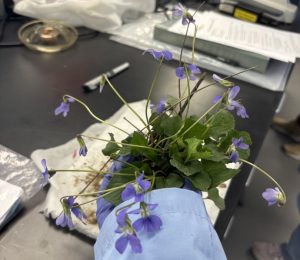
3. Cultivation
- Sunlight: Viola Sororia needs part sun, part shade and a moist soil level to be able to germinate. As seedlings require more shade, as they mature, they can handle increased sunlight. They are typically found in forests because they will begin to grow before the surrounding trees block sunlight. The lack of sunlight reduces evaporation, helping the soil stay moist for ideal conditions.
- Temperature: The best time to plant these violets in your garden is early spring or fall because the cooler temperatures (15°C to 21°C) reduce water loss compared to summer, when the hot weather stresses the plant and dries the soil out. It prefers a pH between 6 and 6.5.
- Preparation: Prepare the soil by removing weeds, rocks, and debris and loosening the soil. Along with a solution to improve water drainage. Plant each seed 6-12 inches apart. If wanting to use fertilizer, a slow-release or organic fertilizer would promote healthy growth. If the plant is in a pot, consider overwintering; otherwise, mulching around the base of the stem would provide extra insulation in the winter and cold months. With proper preparation, seeds will germinate for 14-30 days (Gardenia, 2023).
- Issues: Issues might arise with pests, including violet gall midge, which is the most important pest in the Violaceae family (North Carolina Extension Gardener Plant Toolbox, n.d.). Powdery mildew and leaf spots are possible disease problems.
4. Life Cycle
- Flowering: Viola Sororia’s can take up to 1-2 years to reach full maturity and flourish for 3-5 years until they start dying. As the violet moves from a vegetative state to flowering, its structure and colour adapt. This enhances their ability to self-seed and spread (Rankel, 2024).
- Pollination: Angiosperms pollinate by the placement or transfer of pollen from the anther to the stigma of the same flower to another flower. Butterflies and native bees visit the Viola sororia plant for its nectar in the spring. Pollination is seed dispersal as well as myrmecochory (seed dispersal by ants). The seeds are coated with small, nutrient-rich structures called elaiosomes, which contain proteins and fats which attract ants. Once the seed coating is consumed, the seed is discarded and can germinate.
- Seeds: The flower can also produce its own seeds in late summer from cleistogamy (iNaturalist, n.d.). The seed capsules eventually turn upright and open, shooting their seeds up to 9ft away from the plant.
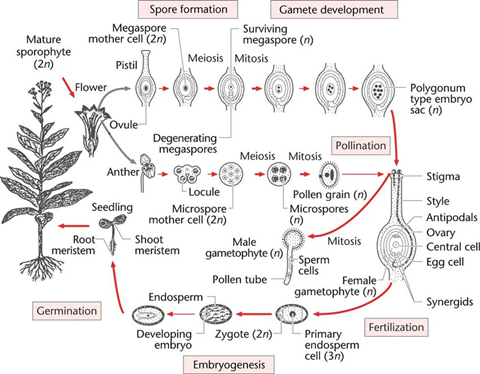
In the female reproductive organs, the pistil, the megaspore mother cells in the ovule undergo meiosis. Only one of the four products of meiosis survives and eventually develops into the eight-celled female gametophyte, containing the egg cell and the central cell (Boavida & McCormick, 2010).In the anther of a sporophyte, pollen is created by microspore mother cells undergoing meiosis to produce four haploid microspores that form a tetrad. For the male gametophytes, each microspore develops into a pollen grain composed of only three cells and two sperm cells (Boavida & McCormick, 2010). The pollen lands on the surface of the pistil, grows a tube to allow it to fertilize through the micropyle with the help from synergid cells that help guide the pollen to the embryo sac to fertilize and create seeds.
5. Anatomy & Physiology
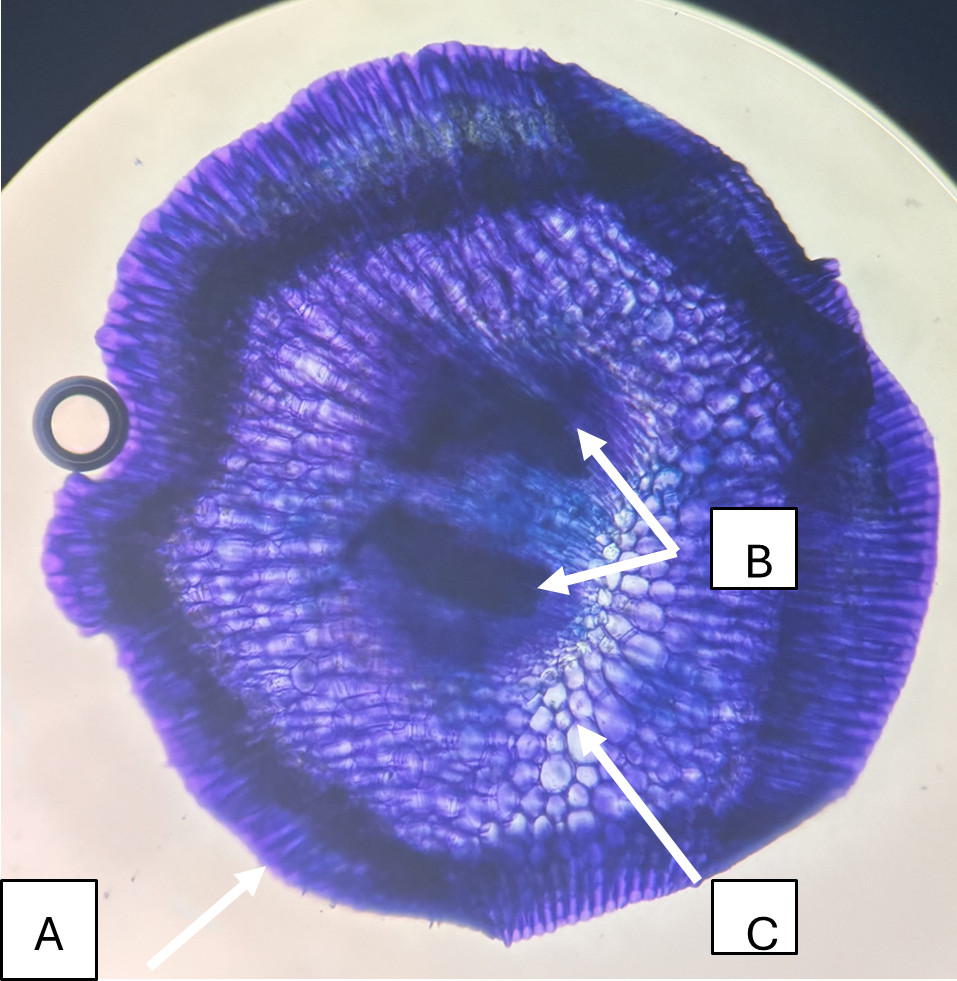
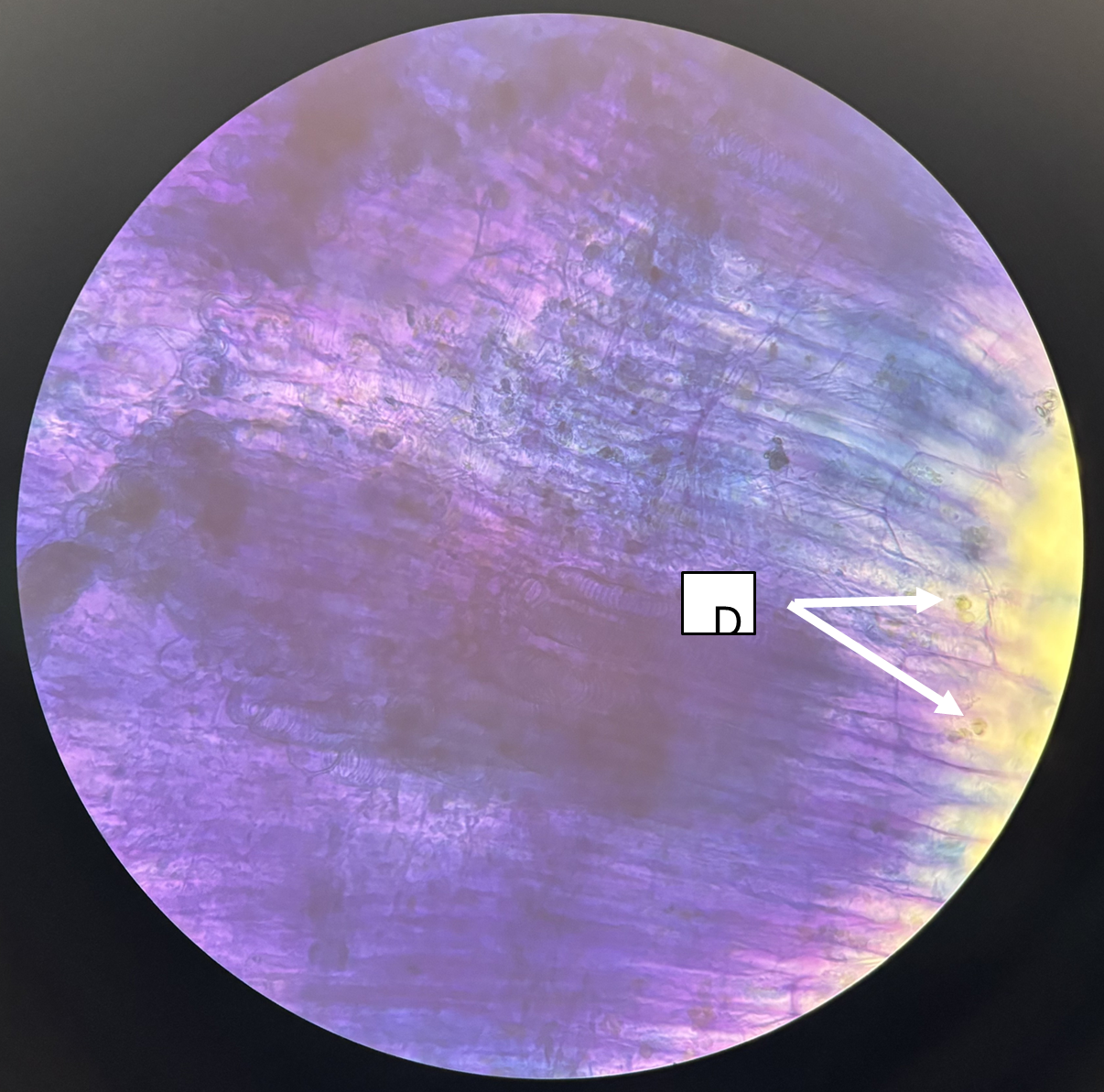
- Meristem cells: Region of continuous cell division and growth. The cells at this point are undifferentiated with no assigned role in the plant yet. Every time a cell divides and becomes another tissue in the plant, one will stay a meristem cell.
- Apical meristem: responsible for root and height elongation.
- Lateral meristem: responsible for increases in diameter
- Tissues: Thanks to the meristematic tissue, cells produced from the process differentiate into dermal, vascular, and ground tissue.
- Dermal tissue: Tissue that covers the outer surface of the plant and controls gas exchange. The dermal tissue of the viola sororia consists of petals, stamen, sepals, and carpels. As well as the outermost layer of the cells, the epidermis, where the stomata perform gas exchange.
- Vascular: Xylem and phloem. This is contained in (B) in Figure 1.7.4. Xylem is responsible for the transportation of water upwards to the dermal tissue. Phloem is responsible for transporting nutrients from the roots to different parts of the plant.
- Ground tissue: Made up of parenchyma cells, and in addition, collenchyma and sclerenchyma cells that help support the stem. Ground tissue is the stem of the plant, and these cells store molecules (such as starch), photosynthesize and support the plant (Clark et al., 2018).
- Parenchyma cells keep the phloem in the vascular tissue alive. They are photosynthetic in leaves and can greatly contribute to the energy of the plant. In roots, they are called the cortex, as seen in Figure 1.7.4. (B).
- Collenchyma cells offer support to the plant and allow it to bend without breaking.
- Sclerenchyma cells are for the structure of the plant and have lignin in their cell walls.
- Roots: V. Sororia contains rhizomes instead of roots. The difference between a root versus a rhizome is that a root absorbs water and nutrients from the soil to the plant, and a rhizome stores food for the plant and transports water and nutrients to other parts of the plant.
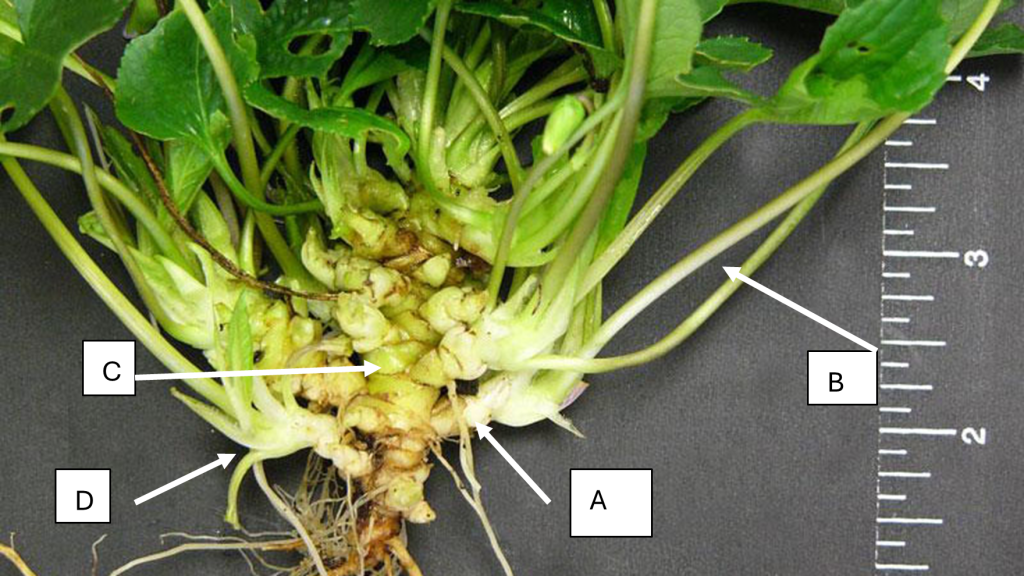
- Shoots: includes nodes and internodes. Nodes are structures where petioles, leaves and flowers emerge from. Internodes are present in Figure 1.7.6, but very compressed due to the new growth. Label B, the petiole, is the stalk that emerges from the node to the leaf. The auxiliary bud is also present, as shown in label D. It gives rise to a petiole.
6. Summary
This violet is an easy beginner plant. Its unique reproduction methods, including being interfertile and its vascular features, make it unique to the Violaceae family.
References
Boavida, L. C., & McCormick, S. (2010). Gametophyte and sporophyte. Encyclopedia of Life Sciences. https://doi.org/10.1002/9780470015902.a0002038.pub2
Clark, M. A., Douglas, M., & Choi, J. (2018). 30.2 Stems. In Biology 2e. OpenStax. https://openstax.org/books/biology-2e/pages/30-2-stems
Gardenia. (2023). Violets (Viola): How to grow and care with success. https://www.gardenia.net/guide/violets-viola-how-to-grow-and-care
iNaturalist. (n.d.). Viola sororia. https://www.inaturalist.org/taxa/82816-Viola-sororia
NC State Extension Publications. (n.d.). Wild violet. https://content.ces.ncsu.edu/wild-violet
New Moon Nursery. (n.d.). Viola sororia. https://newmoonnursery.com/nursery-plants/viola-sororia/
North Carolina Extension Gardener Plant Toolbox. (n.d.). Viola sororia (Common blue violet, confederate violet, dooryard violet, hooded blue violet, hooded violet, meadow violet, Missouri violet, purple violet, sister violet, wild violet, wood violet, woolly blue violet). https://plants.ces.ncsu.edu/plants/viola-sororia/
Northern Ontario Flora. (2018). Viola sororia. https://www.northernontarioflora.ca/?m=H1&id=1000777
Rankel, K. (2024, October 16). Key stages in the life of a blue violet. Greg App. https://greg.app/blue-violet-lifecycle/
Yelverton, F. (2017, November 29). Wild violet. NC State Extension Publications. https://content.ces.ncsu.edu/wild-violet

